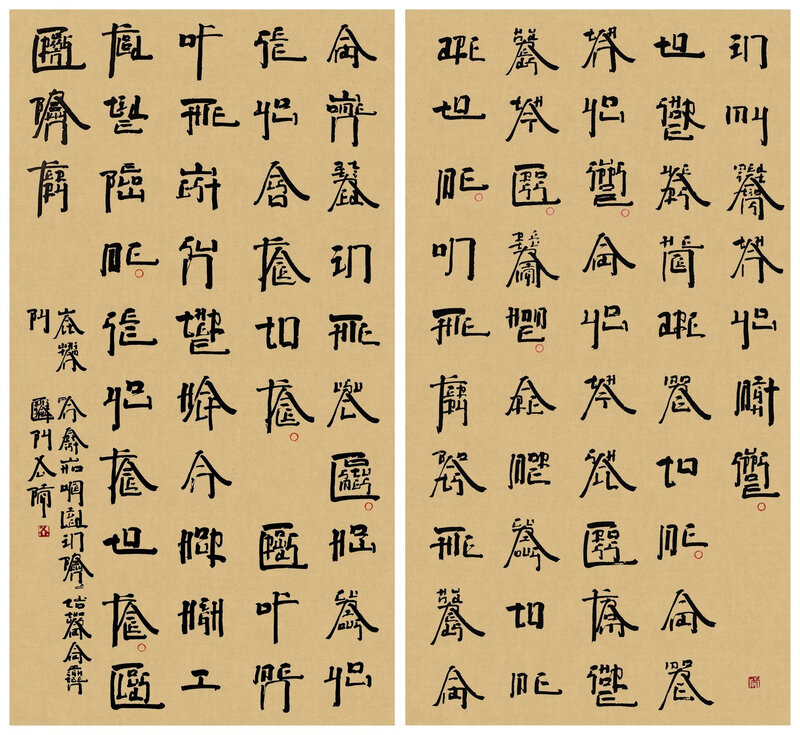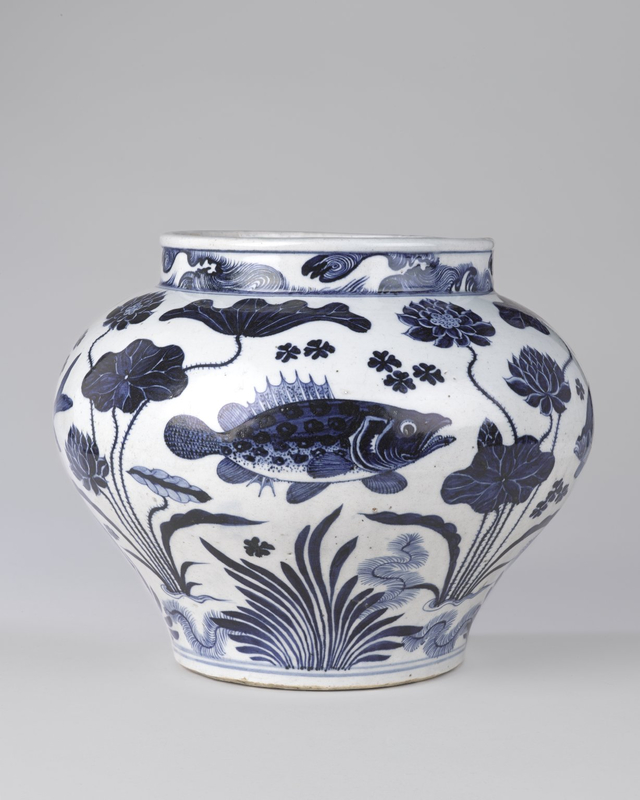Xu Bing's Ode to Walt Whitman Exhibited at Brooklyn Museum's Reinstalled Asian Art Galleries This October
Xu Bing (Chinese, born 1955). Square Word Calligraphy: Crossing Brooklyn Ferry, Walt Whitman, 2018. Ink on paper, 89 3/8 x 48 13/16 in. (227 x 124 cm). Brooklyn Museum, Gift of Xu Bing to the Brooklyn Museum in honor of his father, 2018.24a-b. (Photo: Courtesy of the artist)
Brooklyn Museum will highlight an artwork that honors the famous American poet Walt Whitman on his 200th birthday, on view from October 25, 2019–April 26, 2020.
One: Xu Bing features a new acquisition, Square Word Calligraphy: Crossing Brooklyn Ferry, Walt Whitman (2018), gifted by the artist to mark the reopening of the China collection at the Brooklyn Museum after a major reinstallation.
Xu Bing, widely regarded as one of China’s most important living artists, created this work specifically for the Brooklyn Museum using “square word calligraphy,” a conceptual method of writing English words stylized as Chinese characters that Xu developed while living in Brooklyn in the early 1990s. The resulting painting is a commentary on the immigrant experience of living between two cultures, simultaneously serving as an example of the new traditions and unique perspectives that evolve when cultural experiences are shared.
Xu Bing was born in China in 1955 and immigrated to the United States in the early 1990s. During his time in the U.S., Xu lived in Brooklyn, where he still maintains a studio today. It was only after arriving in New York that the artist developed his “square word calligraphy” system of writing. Although the form of each rectangular unit resembles a Chinese character, the elements are actually English letters. This unique method of writing is a direct result of his living in the U.S. as an immigrant, straddling two cultures and forming roots in a new “home.”
Square Word Calligraphy: Crossing Brooklyn Ferry, Walt Whitman is a prominent new gift to the museum’s collection of Chinese art. The large-scale painting features Whitman’s poem Crossing Brooklyn Ferry, which details the narrator’s journey across the East River on a Brooklyn-bound ferry and the excitement he witnessed among his fellow ferry passengers as they came from Manhattan to Brooklyn. Published as part of his famous collection Leaves of Grass, the Whitman poem uses the shared experience of diverse travelers on a crowded ferry to comment on human relationships across time and place. Similarly, Xu Bing’s homage to the poet celebrates the global interconnectedness experienced by immigrants of different ethnic backgrounds melding cultures and creating new traditions.
Whitman, who was known as the American poet of democracy, also served as an early librarian at the Brooklyn Apprentices’ Library Association, the predecessor to the Brooklyn Museum.
One: Xu Bing will open on October 25 in conjunction with the newly reinstalled Arts of China and Arts of Japan galleries, highlighting the museum’s important and diverse collection of works from both countries.
The Arts of China gallery highlights 5,000 years of Chinese artistic accomplishments, including bronzes, ceramics, painting, and selections from the museum’s unrivaled collection of cloisonné enamels. The installation will include more than 130 works, many of which have not been on view in decades.
Unique to this encyclopedic display of Chinese artworks is the inclusion of contemporary art. Since 2014, the Brooklyn Museum has acquired over fifty contemporary paintings and sculptures by artists of Chinese descent, including Sun Xun, Zheng Chongbin, Peng Wei, Tai Xiangzhou, Zhang Jian-Jun, and Bingyi, among others. The experimental ink paintings by these artists challenge and transform China’s traditional artistic practices, using them to respond to present day concerns such as urbanization, environmental degradation, and the rapid pace of China’s modernization. The contemporary works will be highlighted in a special presentation held in conjunction with the reopening of the Arts of Asia collection, with works from the collection rotating into the galleries on a regular basis.
Wine Jar with Fish and Aquatic Plants, 14th century. Porcelain with underglaze cobalt blue decoration, 11 15/16 x 13 3/4in. (30.3 x 34.9cm). Brooklyn Museum, The William E. Hutchins Collection, Bequest of Augustus S. Hutchins, 52.87.1. (Photo: Brooklyn Museum)
On display in the main China gallery will be historical masterworks from the museum’s collection, including the Yuan dynasty Wine Jar with Fish and Aquatic Plants, widely regarded as one of the finest examples of blue-and-white porcelains in the Western hemisphere; the Shang dynasty bronze ritual vessel (gong), whose design illustrates the spiritual transformation the ancient Chinese believed occurs when communicating with ancestors; and cloisonné enamels. The collection of cloisonné enamels, donated to the museum as part of a major gift in 1909, is one of the finest of its kind in the world. The gallery is organized by thematic sections: Ancient China, Journey to the Afterlife, Reinventing the Past, Hidden Messages and Wordplay, Later Ceramics and Decorative Arts, and Art of the Scholar.
The Arts of Japan gallery will trace over 2,000 years of innovation in Japanese art, including Buddhist temple sculptures, Ukiyo-e prints, paintings, and lacquerware. Among the masterworks on display is an oversized painted wood head of a guardian figure from the thirteenth century, with bared teeth and glinting crystal eyes, that was meant to ward off enemies in a Buddhist temple. It features the energy and exaggerated musculature that typify the best sculptures of the Kamakura period (1185–1333).
Head of a Guardian. Japan, Kamakura period (1185–1333), 13th century. Hinoki cypress wood with lacquer on cloth, pigment, rock crystal, metal, 221⁄16 x 101⁄4 x 1315⁄16 (56.0 × 26.0 × 35.5 cm). Brooklyn Museum, Gift of Mr. and Mrs. Alastair B. Martin, the Guennol Collection, 86.21. (Photo: Brooklyn Museum).
The presentation will also feature contemporary ceramics that represent the cutting edge of ceramic achievement in Japan. By placing these contemporary pieces next to ancient works, the reinstallation illuminates points of continuity throughout the country’s ten-thousand-year history of advancements in ceramics. The Japan gallery is also organized by thematic sections: Ancient Japan, Temple Sculpture in Wood, Tea Taste in Japanese Ceramics, Ashand Clay, Contemporary Japanese Ceramics, Lacquerware, Art of the Ainu People, and Woodblock Prints.

/https%3A%2F%2Fprofilepics.canalblog.com%2Fprofilepics%2F1%2F0%2F100183.jpg)
/https%3A%2F%2Fstorage.canalblog.com%2F03%2F02%2F119589%2F96711876_o.jpg)
/https%3A%2F%2Fstorage.canalblog.com%2F11%2F31%2F119589%2F94773502_o.jpg)
/https%3A%2F%2Fstorage.canalblog.com%2F20%2F83%2F119589%2F94772815_o.jpg)
/https%3A%2F%2Fstorage.canalblog.com%2F26%2F72%2F119589%2F75604929_o.jpg)
/https%3A%2F%2Fstorage.canalblog.com%2F59%2F60%2F119589%2F26458628_o.jpg)





/http%3A%2F%2Fstorage.canalblog.com%2F69%2F63%2F119589%2F129610122_o.jpg)
/http%3A%2F%2Fstorage.canalblog.com%2F34%2F43%2F119589%2F129536359_o.jpg)
/http%3A%2F%2Fstorage.canalblog.com%2F76%2F30%2F119589%2F129536158_o.jpg)
/http%3A%2F%2Fstorage.canalblog.com%2F83%2F20%2F119589%2F129481662_o.jpg)